When it comes to valuing SaaS business, what mattered in 2021 and the beginning of 2022 is not what matters today. The markets have changed drastically, and NRR has become more important than growth. In 2023, you need to do more with less, meaning that being capital efficient should be your number one priority. Nathan Latka, CEO, and Founder of Founderpath, has shared a large set of data on different companies’ NRR, profitability, payback time, and valuation, which we’ll dive into in this article.
Let’s Take a Look at 9 B2B SaaS Example
Three metrics quantify doing more with less: net retention, profits, and payback periods. By interviewing over 200 SaaS founders, Nathan has gathered an extensive data set to compile the three best companies from each of the previously mentioned metrics’ perspectives. Then he will cover why CAC to LTV doesn’t matter, which many find controversial.
Section 1 – More NRR and Fewer New Customers
When planning for Q4 and the following year, you should be asking yourself how you would grow revenue if you couldn’t acquire any new customers. The answer to that question is to expand into your current accounts. Lower growth, such as 70%, is acceptable in this macroeconomic situation, as long as you’re breakeven and 130% NRR.
This is clearly shown in Nathan’s data, where companies such as Yellow.ai with a high NRR are valued significantly higher than others. Wildjar.com and Omnisend.com are two profitable bootstrapped companies with an NRR of 125% and 136% respectively, that are also doing great right now. At the end of the article, we’ve shared what Nathan believes to be “good” and “bad” NRR examples.
Section 2 – More Profits and Less Burn
With so much economic uncertainty, profits and confidence in your continued existence will make you win. Sustainability is currently more important than growth, which wasn’t the case a year ago. Companies with a high burn and low revenue per employee might not be around a few years from now, making it crucial for your company to embrace a sound business model. Here are some profitable SaaS businesses to be inspired by:
- Netcore.com – $95m ARR, $12m Profits.
- Userzoom.com – $80m ARR, $1m Profits.
- Questionpro.com – $20m ARR, $2.4m Profits.
Remember that valuation is about more than growth. Many people have said to Nathan that a lower burn will mean less growth, which will negatively impact their valuation. However, this isn’t the case since valuation is not only about growth. When looking at the fundraising and M&A deal data that Nathan has gathered, it’s clearly seen that profits are highly valuable in today’s market by all types of investors.
Section 3 – More Instant Payback and Less LTV:CAC
If you’re not around long enough to earn your total LTV, an LTV:CAC ratio of five doesn’t mean anything. The number one way SaaS people calculate LTV:CAC is by looking at their gross churn, let’s say it’s five percent, and then they divide one with that churn, which in this case means that a customer will stay for twenty months. If you have a lower churn, this number becomes significantly better.
Then many take that number of months and multiply it by the customer’s revenue each month, and they get their LTV. This might all seem great if you have a low CAC, but the problem is time. In many cases, it simply takes too long to make back your CAC. The most valuable SaaS companies today are not the ones with the best LTV:CAC ratio, but rather the ones that get their payback time down to zero. Ask yourself what you can sell on top of your software subscription that allows you to make all the CAC back instantly. Three examples to gain inspiration from:
- Lob.com – $13k CAC, $9k ARPU, 1.5 months payback.
- Workboard.com – $18k CAC, $10k ARPU, 1.8 months payback.
- vFairs.com – $5k CAC, $2.8k ARPU, 2 months payback.
Data to Benchmark Your Company On
Sound metrics are more important than ever in today’s harsh market, and what was good a year ago isn’t necessarily good today. However, remember that no two companies are the same and that all these metrics work together. For example, fifty percent growth is definitely okay if you’re profitable, but otherwise not. Here Nathan shows what he believes to be a fantastic business, a good business, and a business in danger, based on all the data he’s gathered:
The Fantastic SaaS Business:
- NRR of 140%.
- CAC payback in 1-3 months.
- EBITDA -10%.
- Growth 90%.
- Revenue per Employee of $300k.
The Good SaaS Business:
- NRR of 120%.
- CAC payback in 3-9 months.
- EBITDA -20%.
- Growth 60%.
- Revenue per Employee of $200k.
The SaaS Business in Danger:
- NRR of 110%.
- CAC payback in 9-18 months.
- EBITDA -30%.
- Growth 50%.
- Revenue per Employee of $100k.
9 Tactics to Do More With Less
- CSM’s quota – Give CSMs a target quota of 130% NRR.
- How do you get to $100k? – What does your biggest customer pay today?
- Must focus for $10m ARR – How do you plan to upsell/expand into current customers?
- Outsource – Use Fiverr, Upwork, and Toptal rather than hiring.
- Focus on ARR per employee – $250k is good, and $400k is great.
- Challenge your team – Tell your team that you care about profits.
- What’s at the top of the funnel? – What can you sell to get paid back instantly? (Not SaaS).
- $100 out, $100 in – Try courses, books, and event tickets.
- Money velocity – How fast you get your money back is how you win.
Key Takeaways
- Focus on more NRR and fewer new customers.
- Strive for profits and less burn.
- Payback time is more important than LTV:CAC.




